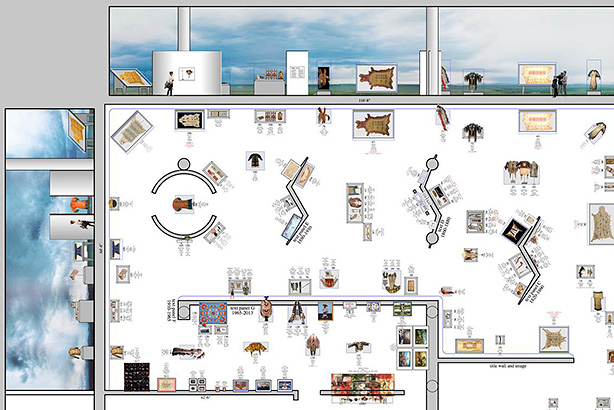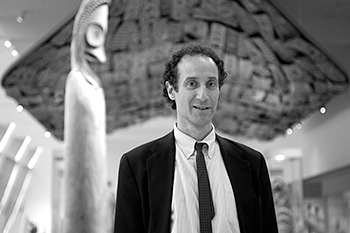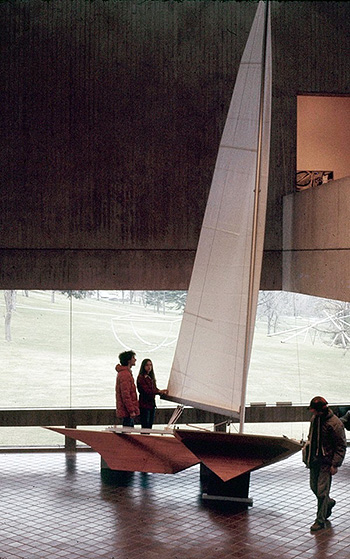
A portion of the exhibition map for Daniel Kershaw's most recent work, "The Plains Indians: Artists of Earth and Sky" at the Metropolitan Museum of Art in Manhattan. Image: The Metropolitan Museum of Art.
Mr. Met: Alumnus sets the stage for great art

Daniel Kershaw '78. Photo: The Metropolitan Museum of Art.
Millions look upon Daniel Kershaw's work each year, yet he hopes his creations go largely unnoticed. As senior exhibition designer for the Metropolitan Museum of Art in Manhattan, Kershaw '78 plans and builds environments for up to a dozen shows annually -- working with curators to develop a landscape for permanent galleries and temporary exhibitions.
His most recent work, "The Plains Indians: Artists of Earth and Sky," earned a rave from The New York Times as "one of the most completely beautiful sights in New York right now." Kershaw's challenge is to create surroundings that accentuate the art without stealing the spotlight.
"My primary mission is to make you appreciate the individual spectacular beauty of these artworks," says Kershaw. "The design must be appropriate and not distract from this mission. But at the same time, the Met is a grand space, and the art and the surrounding environment should have a jaw-dropping quality to it. So I don't mind if visitors gasp at my design a bit as well as the artworks."
For the Plains Indians show (March 9 through May 10, 2015), which included Native American art, headdresses, quilts, painted buffalo hides, beaded garments, ceremonial pipes and other relics, Kershaw wanted the setting to match the majesty of the Great Plains. He started crafting the installation plan nearly two years in advance, deciding to transform a gallery space usually divided into a cluster of small rooms into one expansive room.

For his senior thesis at Cornell, Kershaw, an avid sailor, decided to build his own boat, a 14-foot craft that used ahead-of-its-time hydrofoil technology to race much faster than conventional sailboats. While he was unable to perfect the hydrofoil concept, the boat caught the eye of curators at the Johnson Museum of Art, who displayed it that spring. Photo: Provided.
The exhibition required little wall space, so Kershaw sought panoramic photos of the Great Plains to cover the walls from floor to ceiling. When he couldn't find suitable images, Kershaw discovered an aspiring photographer at a Blackfeet Nation tribal school and sent her a camera to shoot the skies. Her stunning photos were printed and hung atop gallery walls, providing a contemporary tone that signals visitors, "you're in a place where these objects belong," Kershaw says.
That Kershaw would go to such lengths in pursuit of his vision would come as no surprise to his Cornell classmates or professors. As a design and environmental analysis (DEA) major in the College of Human Ecology, Kershaw says he found the space to explore his "wackiest, most far-out ideas."
Take his senior thesis. An avid sailor, Kershaw decided to build his own boat, a 14-foot craft that used ahead-of-its-time hydrofoil technology to race much faster than conventional sailboats. He spent so much time in the DEA shop that faculty members issued him his own key.
Kershaw survived a few test runs on Cayuga Lake, but he recalls, "I mainly got really wet." He couldn't perfect the hydrofoil concept, calling the boat "patently unstable." Still, it caught the eye of curators at the Herbert F. Johnson Museum of Art, who displayed it that spring. Now the boat enjoys a second life -- Kershaw used the mast and hulls to build a bookshelf and desk in his home.
From age 12, Kershaw knew he wanted to be a designer. As a boy, he fell in love with Stone Age history and was "constantly dragging my family to see some ancient monument or tomb." He loved to draw and obsessed about car design, fascinated by "making things differently and better." In high school, he apprenticed under a builder of fine furniture and musical instruments, where he built his own baroque English guitar and played it seriously for many years.
After a year in Carnegie Mellon University's design program, Kershaw transferred to Cornell, where he came to "know a little about a lot of subjects." In a flint knapping course led by an anthropology graduate student, Kershaw crafted obsidian blades and tools -- "rudimentary at best," he says -- that left his hands "bloodied and wounded." He took astronomy with Carl Sagan, architectural history and environmental law. He credits former DEA chair Joe Carreiro with mentoring him and fueling his passion for design.
"You go through school and a tremendous amount of your future is determined by a charismatic individual or two, somebody who just either gets you -- or who you get -- and you just cannot stop listening to and it helps to solidify your focus," says Kershaw, who regularly hosts Cornell interns at the Met. "I'm grateful to Joe for being an enthusiastic supporter of me."
His days of shipbuilding behind him, Kershaw is designing on a much grander stage. For each exhibition, he generally starts on paper, meeting with curators and sketching out a basic plan for the show's environment. Then he does computer modeling to develop detailed blueprints, after which he directs graphic designers, carpenters, painters and other workers to bring his vision to life. Kershaw attributes part of his success as a museum designer to his "old-fashioned liberal arts education, the ability to examine connections between very remote areas of study."
After a quarter century at the Met, Kershaw, who hosted a behind-the-scenes tour of the museum in April for alumni, can't imagine working anywhere else. "From a very young age, I've always been fascinated with design. There's something of that same kid-like rapture that this job evokes as you're dealing with the most important and extraordinary objects from our culture and history," he says. "Having that one-on-one intimacy with these incredible objects make me feel very much alive in my job."

Panoramic view of the Met's "Galleries for Oceanic Art" during a tour held for Cornellians this past April. Kershaw led a complete redesign and installation of this gallery in 2007. Photo: Deborah Surine/College of Human Ecology.